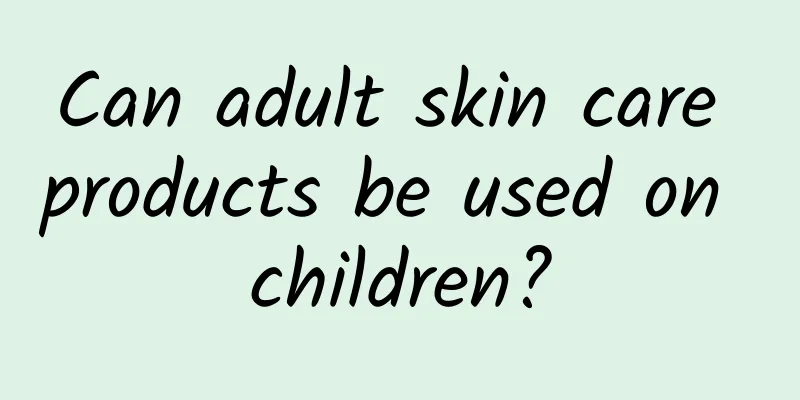Can adult skin care products be used on children?

|
Regarding skin care, I believe many parents will have such doubts. They are all skin, so why are there skin care products specifically for children? And many suggestions also say that children should not use adult skin care products. Is it pretentious or a merchant trap, or is there a scientific reason? So, as children grow up, can they use adult skin care products? Here is the answer: it is best not to. This is not an exaggeration, because children's skin is quite different from that of adults. Let's talk about this issue today. 01. What are the differences between children’s and adults’ skin? For growing children, their skin is different from that of adults. The skin, like most organs and tissues in the body, is the outermost protective tissue of the human body. It also undergoes a gradual growth process after birth. This growth is not only the expansion of the skin surface area as the body grows, but also the change of the skin structure itself. This is the core difference. The differences between children's and adults' skin are specifically manifested in the following aspects: 1. Children’s skin structure is not yet perfect The skin is still in the development stage after birth, and the skin structure of children has not yet fully developed, which is manifested in significant differences from those of adults in terms of the epidermis, dermis and skin appendages such as sweat glands. Taking the most intuitive skin thickness as an example, children's stratum corneum and epidermis are much thinner than those of adults. Data show that children's stratum corneum is 30% thinner and epidermis is 20% thinner than those of adults. Even the cell size is different. Children's epidermal keratinocytes and granular layer cells are smaller than those of adults. For example, the skin appendages such as the eccrine sweat glands are not fully mature after birth, and their neural regulation needs to develop gradually, so the sweating situation of children is obviously different from that of adults. 2. Skin moisture content and pH The moisture content of babies’ skin is also different from that of adults. For example, the moisture content of the stratum corneum of newborns is the lowest, and then it rises rapidly and reaches its highest level after one month, far exceeding that of adults [1]. The water content of the skin can directly affect the skin barrier. It is generally believed that in this case, the skin barrier may be relatively weak. The pH value of the skin is also an important difference. The pH value of an adult's skin is slightly acidic, generally between 4.5 and 6.7. When a baby is born, its skin pH value is close to neutral, around 6.6-7.5. It then shows a gradual downward trend as it grows, but there are still significant differences in the pH value of babies' skin at different ages [2]. 3. Skin renewal speed is different The skin cell renewal rate of newborns is higher than that of adults, and this renewal rate decreases with age. Therefore, the keratinocyte proliferation rate of newborns is the fastest when they are just born. However, this will also cause their skin to desquamate faster, which requires attention in daily life [3]. From the above differences, we can see that the skin of children and adults is very different. In this case, we cannot treat children's skin the same as adults. 02. What are the requirements for children’s skin care products? From the above introduction, we can see that the skin of children and adults is obviously different, whether it is skin structure, skin thickness, water content or pH value. Even infants under 3 years old and children aged 3-12 are obviously different. In this case, adult skin care products are not suitable for direct use on children. After all, skin is different, and adult skin is more concerned with efficacy. However, for babies in the developmental stage, safety is more worthy of attention. Compared with adult skin care products, children's skin care products pay more attention to the following aspects: 1. Safety: Choose safer ingredients and avoid additives that may cause damage to the skin 2. Efficacy: Keep the basic functional ingredients, but be cautious about additional functional ingredients such as whitening and acne removal 3. Formula: Reduce the types of formula ingredients as much as possible We even have a special "Technical Guidelines for Children's Cosmetics" to guide children's skin care products. Skin care products are also divided into infants and toddlers aged 0-3 and children aged 3-12. Especially for children aged 3-12, their skin protection is a matter of concern. Because compared with children under 3 years old, the life scenes of children aged 3-12 have changed a lot, that is: going to school. In my country, children over the age of 3 enter the school-age stage. At this time, they begin to leave their previous families and begin to be more exposed to the environment. For example, the time they spend in public places such as classrooms and restaurants has increased significantly. The environment of these places is obviously different from that of the home, with differences in hygiene, facilities and the environment. Not to mention that after going to school, children's outdoor activities have also increased significantly, such as sports activities, outdoor trips, etc., which are all new lives for babies. Therefore, repair creams for children must be different from those for adults and for infants under 3 years old. 1. Moisturizing The moisture content of children's skin is between that of infants and adults. In addition, children's outdoor activities are far more frequent than those of infants, so attention should be paid to moisturizing. Traditional moisturizing creams for infants and young children often use a higher oil content to achieve moisturizing, which is feasible for infants and young children with low activity levels. However, it is not suitable for children because their activity level increases dramatically, so their sweating amount will also increase. Therefore, it is not suitable to use a large amount of oil for moisturizing. Better moisturizing measures for children need to be developed. 2. Allergy relief Children of school age are more exposed to public places such as classrooms, playgrounds, and restaurants, and have more outdoor activities, so the probability of contact with various allergens is greatly increased. In this case, anti-allergy protection for children is also required. For example, a survey on children's skin sensitivity in a certain place found that the proportion of children who had experienced inflammatory skin diseases such as eczema reached 37.5%. Eczema can also cause the impact of other diseases, as shown in the table below, colds, asthma, and allergic rhinitis may all be accompanied, posing a considerable threat to the baby's health [4]. Therefore, we need to have a deeper understanding of children's skin care. On the one hand, we should not use adult functional skin care products, because children's skin is different from that of adults. On the other hand, the skin and environment of children and infants have changed, so we also need to protect children's skin specifically. [1] Saijo S, Tagami H. Dry Skin of Newborn Infants: Functional Analysis of the Stratum Corneum[J]. Pediatric Dermatology, 2010, 8(2):155-159. [2] Li Li, Xu Zigang, Ma Lin. Detection of some skin barrier parameters in 116 healthy children[J]. Chinese Journal of Dermatology, 2013, 46(006):419-421. [3] Gao Ying, Lu Nan, Zhi Leilei, et al. Research progress on the structure and physiological characteristics of infant skin[J]. Chinese Journal of Aesthetic Medicine, 2015, 24(3):4. [4] Shen Jingxiu. Investigation on the current situation of children's skin eczema in Yongkang Economic Development Zone in 2021 and analysis of risk factors[J]. Chinese Rural Medicine, 2022(029-012). |
<<: MediaPost: How video content marketing and social media can influence the upcoming election
Recommend
What to do if your vagina itches after sex
If there is vaginal itching after intercourse, ma...
The whole country is suffering from pharyngitis. What is going on? Here are 6 tips to relieve sore throat
After the May Day holiday, more and more people s...
What is the story behind the "cassava vermicelli" mentioned on March 15? How should we choose and eat vermicelli?
At this year's 315 Gala, CCTV exposed an inci...
What is the cause of the cystic mass in the left adnexal area?
For some female friends, they should pay attentio...
Can humans only "kill" viruses? Virologists: "Rebellion" is also possible
Most people's impression of biological resear...
What foods are best for low progesterone?
Going to the hospital for regular prenatal check-...
There is a lump in the breast that hurts when pressed
Basically, women often have a problem, that is, t...
What's wrong with heavy menstrual flow?
When women are menstruating, they must take compr...
There is a hard lump when I feel my uterus while lying down
In our daily life, some people feel a lump on the...
Will ectopic pregnancy surgery leave scars?
If an ectopic pregnancy is treated by cesarean se...
Frequent bowel movements during late pregnancy
Feces are metabolic waste that occurs every day i...
What to do with sore eyes during confinement
If women often play with mobile phones during the...
How is emergency contraceptive pills considered successful?
Many women will experience withdrawal bleeding af...
What to do if you have insomnia during early pregnancy
Pregnancy is a very special and important period ...









